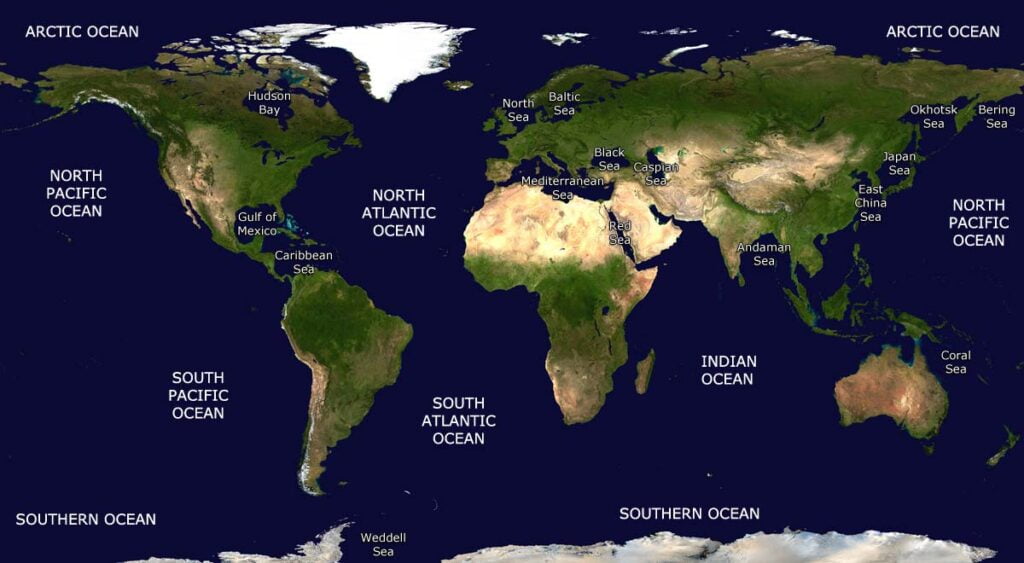Seas are smaller than oceans but hold immense ecological, geographical, and cultural significance. From facilitating trade routes to nurturing diverse ecosystems, the major seas of the world are vital to our planet’s health and human civilization. From the vibrant coral reefs of the Caribbean Sea to the vast expanse of the Philippine Sea, The Major Seas of the World teem with life and ecological wonders. Let’s explore some of the most significant seas and understand their unique characteristics and contributions.

1. The Mediterranean Sea
- Location: Bordered by Southern Europe, Northern Africa, and Western Asia.
- Size: Approximately 2.5 million square kilometers.
- Significance: Often referred to as the cradle of Western civilization, the Mediterranean Sea has been a central hub for trade, culture, and politics for thousands of years. Its azure waters and diverse marine life make it a top destination for tourists. Ancient ports, beautiful coastlines, and remnants of past empires enrich its shores.
2. The Caribbean Sea
- Location: Southeast of the Gulf of Mexico and the North American mainland, east of Central America, and north of South America.
- Size: Around 2.754 million square kilometers.
- Significance: Known for its clear, warm waters and vibrant coral reefs, the Caribbean Sea is a paradise for divers and snorkelers. The area is steeped in a history of exploration, colonization, and piracy, which adds a sense of adventure and mystery to its picturesque islands and cays.
3. The South China Sea
- Location: Part of the Pacific Ocean, it extends from the Singapore and Malacca Straits to the Strait of Taiwan.
- Size: Approximately 3.5 million square kilometers.
- Significance: The South China Sea is one of the busiest maritime regions in the world, essential for global trade. It is also a hotbed of geopolitical tension due to overlapping territorial claims. Despite these issues, the sea boasts rich marine biodiversity and significant oil and gas reserves. Stretches from southern China to the northern coast of Indonesia. Rich in biodiversity, it’s a hotspot for territorial disputes.
4. The Red Sea
- Location: Between northeastern Africa and the Arabian Peninsula.
- Size: About 438,000 square kilometers.
- Significance: Famous for its extraordinary coral reefs and marine life, the Red Sea is a favorite among divers. Its strategic location also makes it an important route for maritime trade between Europe and Asia.
5. The Baltic Sea
- Location: Enclosed by Scandinavia, Finland, the Baltic countries, and the North European Plain.
- Size: Approximately 377,000 square kilometers.
- Significance: The Baltic Sea is crucial for the economies of the surrounding countries. Its brackish waters are a unique mix of saltwater from the North Sea and freshwater from rivers and streams, creating a distinctive ecosystem.
6. The Black Sea
- Location: Bordered by Eastern Europe and Western Asia, connected to the Mediterranean via the Bosporus Strait.
- Size: About 436,000 square kilometers.
- Significance: The Black Sea is historically significant for trade and military strategy. Its rich cultural history and the natural beauty of its coastline attract many visitors each year.
7. The Arabian Sea
- Location: Part of the northern Indian Ocean, bordered by India, the Arabian Peninsula, and the Horn of Africa.
- Size: Roughly 3.86 million square kilometers.
- Significance: This sea has been a crucial part of maritime trade routes for centuries, connecting the Middle East, Africa, and South Asia. Its waters are rich in marine biodiversity and resources like oil and gas.
Conclusion
The seas of the world are more than just bodies of water; they are integral to our planet’s climate, ecosystems, and human activities. Each major sea has its own story, shaped by natural forces and human history. By understanding and appreciating these vast and diverse waters, we can better protect and cherish them for future generations.
Whether you’re a history buff, a nature lover, or a travel enthusiast, exploring the world’s major seas offers endless opportunities for discovery and adventure. So next time you gaze out at the ocean, remember the incredible stories and significance that lie beneath the waves.
TO LEARN MORE ABOUT OCEANS AND SEAS CLICK BELOW
- The Bermuda Triangle Mystery
- The Jatinga Mystery
- Odisha’s ‘Bermuda Triangle’ Remains an Unsolved Mystery
- The Sargasso Sea: A Unique Oceanic Marvel
- Understanding the Differences: Ocean, Sea, Bay, and Gulf
- Exploring the World’s Oceans: A Comprehensive Guide
- Major Marginal Seas of the World’s Oceans
- The Panama Canal
- Major Lakes in India
- Volcanic Islands of India
- River Delta Ecosystems
- The Mysteries of the Antarctic Ocean
- The Crude Oil Filtering Process
- The Greening of Our Oceans: A Silent Signal of Global Change







Thanks for sharing. I read many of your blog posts, cool, your blog is very good.
Can you be more specific about the content of your article? After reading it, I still have some doubts. Hope you can help me.